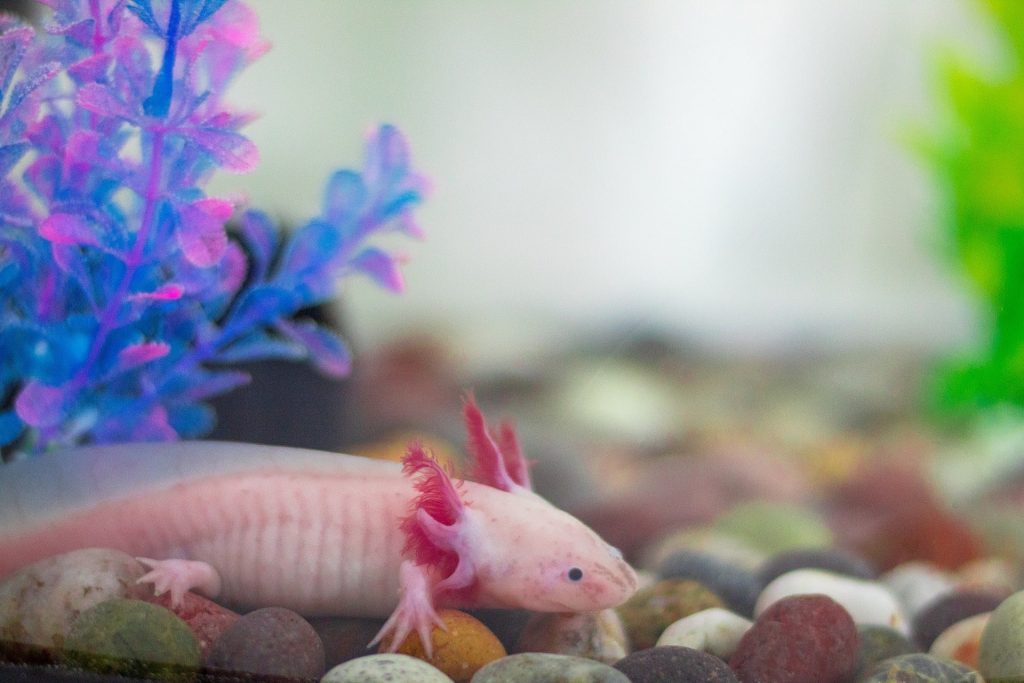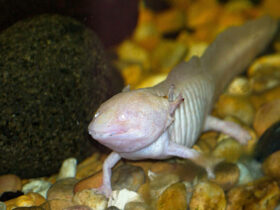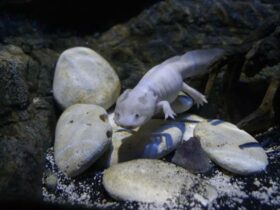
Contents
Do Axolotls Live Long? – Introduction

Have you ever wondered why some animals seem to live forever while others have short lifespans? You’re not alone. Scientists have long been fascinated by animals exhibiting negligible senescence, meaning they show little signs of aging as they age. One such creature is the adorable axolotl, a salamander found in Mexico. These aquatic amphibians can live up to 15-20 years, which is impressive for such a small animal. How do these little guys seemingly escape the aging process that eventually catches up to all of us? It turns out axolotls are masters of regeneration with biological mechanisms that repair and replace cells and tissues, allowing them to achieve a kind of functional immortality.
In this article, we’ll explore the mysteries of axolotl longevity and what they can teach us about slowing down aging. The secret to eternal youth may be closer than we realize, hidden in the DNA of this fascinating and quirky creature.
Axolotls: The salamanders that snack on each other (but don’t die) – Luis Zambrano: https://m.youtube.com/watch?v=uooR4293p_4&t=5s&pp=ygUXRG8gQXhvbG90bHMgTGl2ZSBMb25nPyA%3D
How Long Do Axolotls Live in Captivity?
Axolotls can live 10-15 years; some individuals have been known to reach 20 years of age with proper care. As pets, axolotls require an aquarium setup that mimics their natural habitat. If you provide the right environment and diet, your axolotl companion can thrive for over a decade.
Aquarium Size and Conditions
Axolotls need a spacious aquarium, at minimum, a 20-gallon long tank for one axolotl and ten extra gallons for any additional axolotls. They are active swimmers, so more room is better. Axolotls also require the following conditions:
•Cool water between 60 to 68°F. Use aquarium chillers and heaters to maintain the proper temperature.
•A secure lid, aquatic plants, or other decor where the axolotl can hide. Axolotls can climb smooth surfaces and may jump out of open tanks.
•A filter and aquatic pump to keep the water clean and provide some water flow. Perform regular partial water changes of about 25% of the tank volume weekly.
• Substrates like fine sand or bare bottom are best. Axolotls can choke on gravel.
•Dim lighting. Too much light can stress axolotls.
•Test water conditions regularly and treat any imbalances. Axolotls prefer soft, slightly acidic water.
Diet
A healthy, nutritious diet will support your axolotl for many years. Feed juvenile axolotls daily and adults 2-3 times a week. Offer a variety of foods like:
• Earthworms (a staple food)
• Waxworms, bloodworms and brine shrimp
• Commercial pelleted food (as a supplement)
• Chopped liver, shrimp, and feeder fish (in moderation)
Providing the proper environment, nutrition, and care will allow your axolotl to live a long, healthy, happy life. With some TLC, these fascinating amphibians can make endearing lifelong pets.
Factors That Affect an Axolotl’s Lifespan
Axolotls can live 10-15 years on average, but some individuals have been known to reach 20 years or more with proper care. Several factors determine how long your axolotl will live.
The tank environment plays a major role. Axolotls need a large tank, at least 20 gallons for one axolotl and 10 gallons for any extra axolotls. Perform regular partial water changes of about 25% of the tank volume every week or two to keep conditions clean and comfortable. The water should be dechlorinated and between 60 to 68°F.
The diet also impacts longevity. Axolotls should be fed a diet of protein-rich foods 2-3 times a week. Good options include nightcrawlers, red wigglers, shrimp, and pelleted axolotl food. Only offer as much food as your axolotl can eat in one feeding. Overfeeding can shorten lifespan.
Handling and stress levels are important to consider. Limit handling and interaction with your axolotl as much as possible. Too much contact and stress can negatively impact their lifespan. Only handle axolotls when necessary for tank maintenance.
An axolotl can live a long and healthy life with the proper habitat, nutrition, limited handling, and low stress. Following these best practices will give your axolotl the best chance at reaching and exceeding the average lifespan. Your axolotl companion can remain by your side for many years if you provide what they need to thrive.
Providing the Best Care for Your Axolotl
Providing the proper care and environment is key to keeping your axolotl healthy and happy for many years. The most important things you can do include:
•Housing your axolotl in a spacious aquarium with a secure mesh or screen lid. A 20-gallon long aquarium is a good size for one axolotl. Be sure to keep a secure lid on at all times, as axolotls can climb well and may jump out of an open tank.
•Using a filter and performing regular partial water changes. Axolotls produce a lot of waste and need clean, oxygenated water. Aim for replacing about 25% of the tank water every week using a gravel vacuum to remove waste from the bottom of the tank. Ensure any filter you use has a low flow, as axolotls do not like strong currents.
•Maintaining the proper temperature. Axolotls are cold-water animals and need temperatures between 60 to 68 F. Use aquarium chillers or fans to keep the temperature in the proper range. Temperatures over 70 F can stress your axolotl and make them prone to disease.
•Feeding your axolotl a diet of worms and insects. Good options include earthworms, waxworms, and red wigglers. Feed juveniles daily, while adults only need to be fed 2-3 times a week. Give your axolotl as much food as possible in about 5 minutes at each feeding.
•Performing regular health checks on your axolotl. Look for signs of injury or illness like fungus, parasites, cuts, and scratches. Be alert for behavior changes, such as lack of appetite or lethargy. Take your axolotl to an exotic vet if you notice any issues.
•Giving your axolotl plenty of hiding spots and things to explore. Use live or artificial plants, caves, and tunnels. Axolotls are playful and curious animals and need environmental enrichment to keep them stimulated.
Providing the essential elements of suitable habitat, nutrition, and proper care will maximize your axolotl’s lifespan and quality of life. Your axolotl can live 10-15 years or more with the right conditions and dedication.
Common Health Issues in Axolotls and How to Prevent Them
Axolotls can live 10-15 years; some individuals have been known to live up to 25 years with proper care. However, there are a few common health issues to be aware of to keep your axolotl happy and thriving for a long time.
Poor Water Quality
The most frequent problem is poor water quality with high nitrate, ammonia, or pH levels. Axolotls have sensitive skin and gills so unclean water can lead to disease and damage. Perform regular partial water changes of about 25% of the tank volume weekly and frequently test water conditions to ensure all levels stay in the proper range for axolotls. Never release an axolotl into a pond or wild water; this can introduce disease and damage the local ecosystem.
Nutritional Deficiencies
Axolotls require a diet high in protein and certain nutrients to stay healthy. Feed your axolotl a staple diet of axolotl pellets and occasional treats like earthworms, shrimp, and feeder fish. Gut-loaded feeder insects can also provide extra nutrition. Lack of nutrients can cause stunted growth, illness, and a shortened lifespan.
Injuries and Wounds
Axolotls can accidentally injure themselves on tank decor, heaters, filters, and other axolotls. Check your tank regularly for any sharp edges or surfaces that could cut or scrape. Quarantine any injured axolotls immediately and treat minor wounds with iodine or a commercial amphibian antiseptic. More serious injuries will require a vet visit.
Maintaining excellent water quality, a proper diet, and an injury-free environment can help ensure your axolotl lives long and healthy. Performing routine maintenance and checkups will allow you to notice any health issues early and immediately get your axolotl necessary treatment. If you see signs of disease or distress in your axolotl, consult an exotic vet as soon as possible.
Do Axolotls Die of Old Age? The Truth About Senescence in These Salamanders
Axolotls are known for their longevity and ability to regenerate body parts, but do they die of old age? The truth is axolotls can live 15-20 years on average, and some individuals have been known to live up to 25-30 years. While they are not immortal, their lifespan is quite long for amphibians.
Slowing Down Cellular Aging
Axolotls show negligible senescence, meaning they experience little to no decrease in reproduction or an increase in mortality as they age. Their cells and tissues age very slowly, allowing them to maintain a juvenile, larval form their entire lives. Axolotls continue reproducing into old age and seem to die primarily from injury or disease rather than aging.
Scientists believe axolotls have special mechanisms that protect their cells and DNA from damage over time. Their cells regenerate and divide steadily, avoiding the accumulation of mutations that accelerate aging in other animals. Axolotls also have enhanced mechanisms for repairing DNA and maintaining the length of telomeres, the end caps of chromosomes that shorten with age.
While axolotls aren’t immortal, their negligible senescence and slow aging process are remarkable. By studying how these salamanders can evade aging, scientists hope to find clues that could someday help humans live longer, healthier lives. The axolotl remains an animal model with enormous potential for understanding longevity and developing anti-aging therapies.
Though axolotls can live to a ripe old age, as they get older, their mobility may decrease, and they can become more prone to health issues. Providing an ideal environment, a high-quality diet, and regular checkups with a vet experienced with axolotls will help ensure your pet salamander lives a long, happy, and healthy life. Your axolotl companion could be by your side for many years with proper care.
Conclusion
So there you have it, the secret to the axolotl’s long life unveiled at last. While they may look like creatures from a sci-fi movie, axolotls are real animals that have fascinated scientists for years with their longevity and regenerative abilities. Now we know their superpower comes down to a few key factors: many cells with long telomeres, an efficient antioxidant system, and a slow metabolism. If only humans could figure out how to unlock life-extending mechanisms for ourselves.
But until then, we’ll have to remain in awe of these strange salamanders and their mysterious, Methuselah-like lifespans. By protecting their habitats and learning their secrets, we’ll gain more than just insights into aging but a greater appreciation for the wonders of nature.
More Links:
Is A axolotl A Boy or a girl? – Decoding the Gender of Axolotls – An Amazing Explanation
Are Blue Axolotls Real? – The Rarity of Blue Axolotls: Myth or Reality?





Leave a Reply